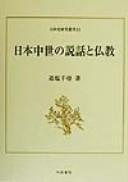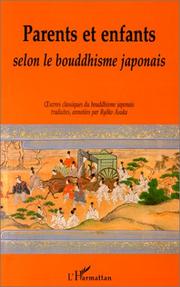| Listing 1 - 10 of 15 | << page >> |
Sort by
|
Book
Year: 1965 Publisher: Paris : Éditions Albin Michel,
Abstract | Keywords | Export | Availability | Bookmark
 Loading...
Loading...Choose an application
- Reference Manager
- EndNote
- RefWorks (Direct export to RefWorks)
Book
ISBN: 4831802891 Year: 2001 Publisher: Kyōto-shi : Hōzōkan,
Abstract | Keywords | Export | Availability | Bookmark
 Loading...
Loading...Choose an application
- Reference Manager
- EndNote
- RefWorks (Direct export to RefWorks)
Buddhism --- Buddhist literature, Japanese --- History and criticism.
Book
Year: 1965 Publisher: Paris : A. Michel,
Abstract | Keywords | Export | Availability | Bookmark
 Loading...
Loading...Choose an application
- Reference Manager
- EndNote
- RefWorks (Direct export to RefWorks)
Book
Abstract | Keywords | Export | Availability | Bookmark
 Loading...
Loading...Choose an application
- Reference Manager
- EndNote
- RefWorks (Direct export to RefWorks)
Buddhist literature, Japanese --- History and criticism --- Minamoto, Tamenori
Book
Year: 1926 Publisher: [Kyoto] : Ryūkoku Daigaku Toshokan,
Abstract | Keywords | Export | Availability | Bookmark
 Loading...
Loading...Choose an application
- Reference Manager
- EndNote
- RefWorks (Direct export to RefWorks)
Buddhism --- Buddhist literature, Japanese --- Buddhist literature, Chinese --- Library catalogs. --- Classified catalogs. --- Ryūkoku Daigaku.

ISBN: 4757600194 Year: 1999 Publisher: 大阪 和泉書院
Abstract | Keywords | Export | Availability | Bookmark
 Loading...
Loading...Choose an application
- Reference Manager
- EndNote
- RefWorks (Direct export to RefWorks)
Buddhism --- Buddhist literature, Japanese --- Buddhist parables --- Folk literature, Japanese --- Legneds, Buddhist --- Folklore --- History --- History and criticism
Book
ISBN: 0472221043 Year: 2023 Publisher: Ann Arbor, Michigan : University of Michigan Press,
Abstract | Keywords | Export | Availability | Bookmark
 Loading...
Loading...Choose an application
- Reference Manager
- EndNote
- RefWorks (Direct export to RefWorks)
When the young Princess Sonshi became a Buddhist nun in the year 984, a scholar-official of the royal court was commissioned to create a guide to the Buddhist religion that would be accessible for her. He did so in the form of the illustrated works of fiction (monogatari) that appealed to women readers of her time and class. The text has survived in later manuscripts; the illustrations, if they ever existed, have not. This revised translation recreates Sonshi's experience of receiving this multimedia presentation, with illustrations selected to help contemporary readers visualize its content and essays that provide context on the religious and cultural experience of the author. The Three Treasures is a unique document that opens a window onto the world of Buddhist religious experience--especially for women--in high classical Japan, the time of Sei Shōnagon's Pillow Book and Murasaki Shikibu's Tale of Genji.
Buddhism --- Buddhist legends --- Buddhist literature, Japanese. --- Minamoto, Tamenori, --- Criticism and interpretation.
Multi
ISBN: 9780231518338 9780231146593 0231146590 0231518331 Year: 2013 Publisher: New York, NY : Columbia University Press,
Abstract | Keywords | Export | Availability | Bookmark
 Loading...
Loading...Choose an application
- Reference Manager
- EndNote
- RefWorks (Direct export to RefWorks)
Wondrous Brutal Fictions presents eight seminal works from the seventeenth-century Japanese sekkyo and ko-joruri puppet theaters, many translated into English for the first time. Both poignant and disturbing, they range from stories of cruelty and brutality to tales of love, charity, and outstanding filial devotion, representing the best of early Edo-period literary and performance traditions and acting as important precursors to the Bunraku and Kabuki styles of theater.As works of Buddhist fiction, these texts relate the histories and miracles of particular buddhas, bodhisattvas, and local deities. Many of their protagonists are cultural icons, recognizable through their representation in later works of Japanese drama, fiction, and film. The collection includes such sekkyo "sermon-ballad" classics as Sansho Dayu, Karukaya, and Oguri, as well as the "old joruri" plays Goo-no-hime and Amida's Riven Breast. R. Keller Kimbrough provides a critical introduction to these vibrant performance genres, emphasizing the role of seventeenth-century publishing in their spread. He also details six major sekkyo chanters and their playbooks, filling a crucial scholarly gap in early Edo-period theater. More than fifty reproductions of mostly seventeenth-century woodblock illustrations offer rich, visual foundations for the critical introduction and translated tales. Ideal for students and scholars of medieval and early modern Japanese literature, theater, and Buddhism, this collection provides an unprecedented encounter with popular Buddhist drama and its far-reaching impact on literature and culture.
Theatrical science --- Sekkyō jōruri. --- Buddhist literature, Japanese --- Japanese drama --- Puppet plays, Japanese --- History and criticism.

ISBN: 2738473504 9782738473509 Year: 1999 Volume: 2 Publisher: Paris: L'Harmattan,
Abstract | Keywords | Export | Availability | Bookmark
 Loading...
Loading...Choose an application
- Reference Manager
- EndNote
- RefWorks (Direct export to RefWorks)
Dans ce nouvel ouvrage de Asuka Ryôko sont regroupés cinq textes. Quatre romans et un sûtra du bouddhisme japonais. Appartenant pour trois d'entre eux à la catégorie des sekkyô, légendes religieuses récitées par les bouddhistes afin de dispenser leur enseignement, ces textes ont été choisis pour illustrer le thème des relations entre parents et enfants. Tour à tour, les récits décrivent la force et la constance des liens qui unissent les parents à leurs enfants dans un monde bouddhique que caractérise pourtant l'impermanence de toutes choses (mujô), principe selon lequel tout ce qui naît passe nécessairement. Dans Iwaya no sôshi, la ferveur de sa foi dans le Bodhisattva Kannon ainsi que son amour pour ses parents sauvent la Princesse de ses mésaventures. Dans Aigono-Waka, la fidélité du héros pour son père saura finalement avoir raison de l'amour aveugle que ce dernier porte à sa seconde épouse. Dans Karukaya, la pratique assidue du bouddhisme tient éloignés le père et le fils, mais c'est cette même dévotion qui les réunira en Terre Pure. Dans Sanshô-dayû, enfin, la méchanceté de l'intendant ne peut venir à bout des liens plus que tenaces par lesquels se trouve unie la famille de Zushiô. Ce dernier récit est particulièrement célèbre et a retenu l'attention à la fois de l'écrivain Mori Ogai (1915) et du réalisateur Kenji Mizoguchi (1954). Ces œuvres classiques du bouddhisme japonais enseignent certes les devoirs réciproques entre parents et enfants, mais, de manière plus générale, ils présentent une conception du monde que règlent des valeurs étrangères à notre société occidentale. En cela, le livre de Asuka Ryôko a une portée qui ne laissera insensibles ni les lecteurs novices ni les connaisseurs en matière de culture japonaise.
Buddhist literature, Japanese --- Japanese literature --- Parent and child in literature --- History and criticism --- J1809 --- Japan: Religion -- Buddhism -- theory, methodology and philosophy --- Buddhist literature, Japanese - History and criticism --- Japanese literature - To 1868 - History and criticism
Book
ISBN: 463900608X 9784639006084 Year: 1986 Publisher: 東京 雄山閣
Abstract | Keywords | Export | Availability | Bookmark
 Loading...
Loading...Choose an application
- Reference Manager
- EndNote
- RefWorks (Direct export to RefWorks)
| Listing 1 - 10 of 15 | << page >> |
Sort by
|

 Search
Search Feedback
Feedback About UniCat
About UniCat  Help
Help News
News